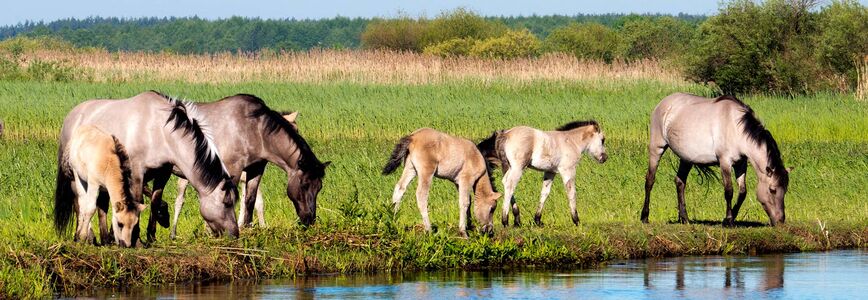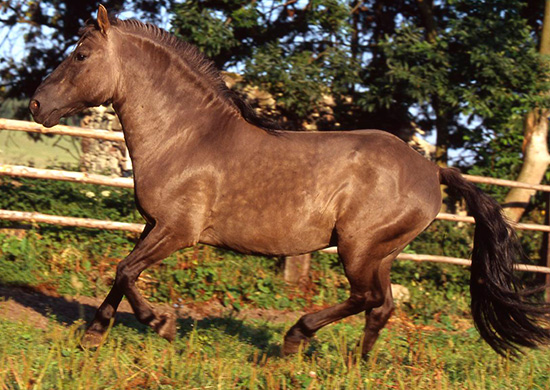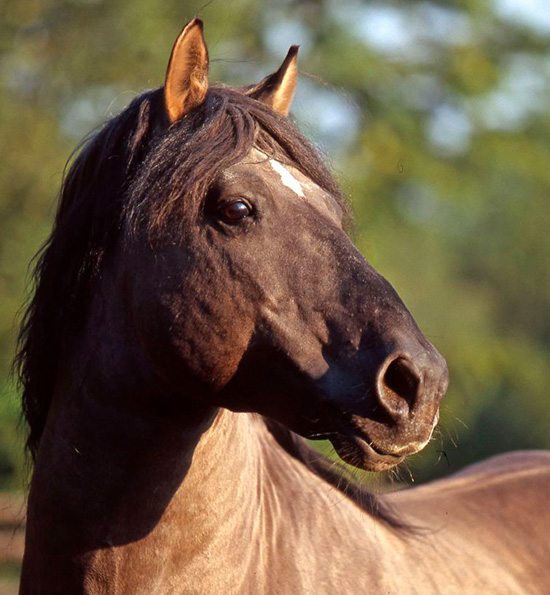
The Tarpan horse breed is the extinct form of wild horses. Due to their headstrong nature, they are less suited for equitation.
Breed:
Tarpan horse
Group:
small horses
Height at the withers:
130 - 145 cm
Appearance:
medium-sized head with a striking profile with a light, arched muzzle, wide forehead, short but strong neck, rounded, slightly arched croup, short legs, often zebra-like stripes on the pastern
Colour of coat:
dun-coloured, especially mouse dun
Character:
intelligent, resilient, headstrong, reliable
Origin:
Central Europe
Suited for:
working and recreational horses, pasturing for nature conservation, carriage driving
Did you know? The original, wild Tarpan horses were very shy and freedom-loving. Therefore, they wouldn’t have done well in a stable or a zoo. In the wild, however, they were able to fend of enemies: They even fought off wolves with their front hooves. All in all, they were significantly wilder and more untamed than today’s bred back horses.

Tarpan horses have a unique character.
Originally, Tarpan horses were wild horses that were very common in Eurasia. There is a possibility that domestic horses originate from Tarpan horses, because they have the same number of chromosomes. On the other hand, Przewalski’s horses, which were considered to be the modern horses’ predecessors for a long time, have two chromosomes more. However, there is no way to determine this exactly, as the last wild horses of this particular breed have been extinct since the end of the 19th century. There are different opinions as to when the last Tarpan horses lived. Probably most free-roaming Tarpan horses, that have been reported of since the 18th century, were already feral domestic horses crossbred with wild horses – rather than actual wild horses.
Nevertheless, horses similar to Tarpan horses can be found in many animal parks and zoos today. They were bred back from breeds closely related to Tarpan horses and look very similar to the original wild horses. The brothers Lutz and Heinz Heck were the first breeders to try breeding back these horses. They used Przewalski’s stallions originating from Mongolia and crossbred them with mares of different breeds: Dülmener horses, Icelandic horses, Gotland ponies as well as Konik horses. These so-called “Heck horses” were further crossbred with Konik horses, a very sturdy pony breed from Central and Eastern Europe that is similar to wild horses. The brothers Heck believed to have brought back the extinct breed. They even referred to the breed as Tarpan horses. However, today’s Tarpan horses are very similar to the original wild horses, and they are extremely sturdy – but they are not real wild horses and not genetically “real” Tarpan horses.

They used to be wild horses: Tarpan horses
Tarpan horses not only look like wild horses, they are more headstrong than normal working or riding horses, too. This is why, despite their small size, they are only suitable for children, if they underwent thorough training. Today, they are popular as working and packing horses, because they are enduring, tough and humble. However, these horses can also be extremely wilful, which makes them less suitable for equitation.
The small horses have fairly short legs with very hard hooves. Their coat is usually mouse grey, but they also come in other colours. Their guard hairs are usually darker. Unlike Przewalski’s horses, the Tarpan horses’ mane is a hanging mane, not a stand-up mane. At times, the rare Przewalski’s horses were crossbred with Heck’s horses, because it was believed that the European wild horses had stand-up manes… However, this wasn’t successful. Their dark eel line and the light muzzle is also typical. Many Tarpan horses also have typical Zebra stripes on the legs that make them look like wild horses. They look very similar to Konik horses, which are however larger and also suited for riding.